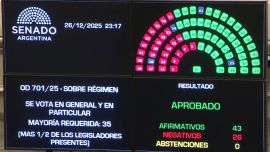Government data shows that 89 percent of Argentines live in a household that has received some form of state assistance in April.
In contrast, just four million of Argentina’s 44-million strong population did not receive some form of relief, whether it be family benefit, pension and emergency wage relief payments, as well as public-sector salaries. Others have received help with mortgages.
To pay for all this the money now being printed outweighs genuine tax revenue, data shows.
The figures emerged from the June edition of the Productive Development Ministry’s Productive Panorama Report, which said all sectors – with the exception of medicines, agrochemicals and food – were now classified as "red," the lowest of its three-tier classification system.
"Economic recovery has begun but the sequels of the pandemic are making themselves felt, " concludes the report.
"Between February and April some 15,000 companies (around 2.8 percent of the total) ceased presenting their sworn statements of social security payments to AFIP tax bureau; the sector of hotels and restaurants was the most affected with an eight percent fall in the number of companies declaring. Even if it would be premature to catalogue these cases as definite closures, these figures illustrate the damage done by Covid-19," the report said.
Argentina was already suffering a two-year recession before the virus crisis arrived. The economy's immediate outlook is compounded by the lockdown, with a sharp fall in fiscal revenues anticipated.
President Alberto Fernández has said previously his stimulus programme will amount to some 550 billion pesos (US$8 billion at the current exchange rate).
For example, some 12 million people registered for the emergency family income (IFE, in its Spanish acronym) of 10,000 pesos (US$150), of whom almost eight million qualified. Over 220,000 companies are claiming financial relief to stave off bankruptcy, according to the government.
The Productive Development Ministry also revealed that job losses topped 100,000 between March and April when only taking into consideration the formally employed. These losses, according to the report, respond to "various reasons – resignations, the termination of contracts, trial periods, etc. – and are not compensated by anybody being hired. To these must be added the lay-offs, with 7.5 percent of the employed being suspended in April."
ATP (Asistencia al Trabajo y la Producción) wage assistance bulked larger in some sectors than others with the biggest percentage (82.4 percent) in hotels, restaurants, cultural services, sports and leisure, followed by manufacturing industry (67.3 percent), construction (62.5 percent) and real estate (64.3 percent). The lowest percentages were in education (7.3 percent) and information and communications (36.9 percent).
– TIMES/NA




















Comments